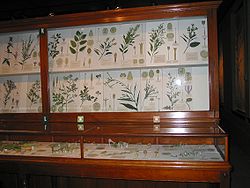Harvard Museum of Natural History
[citation needed] In the museum's permanent galleries, visitors encounter the diversity of life on Earth, from dinosaurs to fossil invertebrates and reptiles, to large mammals, birds and fish, and the only mounted Kronosaurus.In addition, a series of changing exhibitions bring focus to new research at the University.The museum offers educational programs and has a partnership with Cambridge public schools; offers public lectures by Harvard biologists, international conservationists, and popular authors; and has a travel program where small groups are led by Harvard science faculty to biodiverse locations.The museum is member-based, with over 3,200[needs update] current members, primarily from the Boston metropolitan area.While the museum is affiliated with the Harvard's Faculty of Arts and Sciences and receives important support from the University, it derives most of its operating income from admissions, membership, gifts, and programmatic revenues.


Cambridge, MassachusettsCoordinatesHarvard UniversityHarvardMBTA Red Linenatural history museumUniversity Museum BuildingHarvard University HerbariaMuseum of Comparative ZoologyHarvard Mineralogical MuseumPeabody Museum of Archaeology and EthnologyHarvard Museum of the Ancient Near EastPeabody MuseumCollection of Historical Scientific InstrumentsHarvard Mineralogical and Geological Museumright whalefossilmammalsKronosaurusmeteoritesgemstonesBlaschkaGlass FlowersBlaschka models of marine invertebratesHistoryJohn HarvardstatuePresidentAlan GarberBoard of OverseersPresident and FellowsJohn ManningLibraryArts and SciencesHopi HoekstraCollegeRakesh KhuranaRadcliffe CollegeFreshman dormitoriesCurrierDudleyDunsterKirklandLeverettLowellMatherPforzheimerQuincyWinthropUndergraduate organizationsHasty Pudding TheatricalsThe Harvard AdvocateThe Harvard CrimsonThe Harvard IndependentThe Harvard LampoonContinuing EducationExtension SchoolExtension School historySummer SchoolEngineering andApplied SciencesDavid C. ParkesLyman Laboratory of PhysicsGraduate SchoolEmma DenchHarvard-YenchingHoughtonHarvard ReviewLamontWidenerHarry Elkins WidenerEleanor Elkins WidenerGrossmanAsia CenterCenter for African and African American ResearchDu Bois InstituteCenter for AstrophysicsCenter for Chinese StudiesCenter for European StudiesCenter for Visual ArtsCenter for Hellenic StudiesDumbarton OaksHarvard ForestRowland InstituteUkrainian Research InstituteBusinessSrikant DatarBaker Library/Bloomberg CenterHarvard Business PublishingHarvard Business ReviewHarvard Business School RFCSpangler CenterDesignSarah WhitingHarvard Design MagazineCenter for Housing StudiesDivinityDavid N. HemptonEducationBridget Terry LongGovernmentAsh CenterBelfer CenterCarr CenterCenter for EthicsCenter for Nonprofit OrganizationsCenter for Public LeadershipInstitute of PoliticsRappaport InstituteShorenstein CenterThe Journalist's ResourceJohn F. ManningBerkman Klein CenterCivil Rights-Civil Liberties Law ReviewInternational Law JournalJournal of Law & TechnologyJournal on LegislationLaw RecordLaw ReviewMedicineGeorge Q. DaleyBroad InstituteMedical LibraryAnatomical MuseumProgram in Health SciencesSchool of Dental MedicinePublic Health